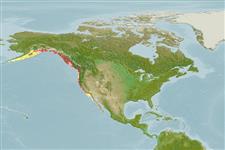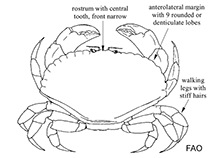Cancer productus Randall, 1840
Red rock crab| Native range | All suitable habitat | Point map | Year 2050 |

|
| This map was computer-generated and has not yet been reviewed. |
| Cancer productus AquaMaps Data sources: GBIF OBIS |
Google image | No image available for this species;
drawing shows typical species in Cancridae.
Classification / Names Common names | Synonyms | CoL | ITIS | WoRMS
Malacostraca | Decapoda | Cancridae
Environment: milieu / climate zone / depth range / distribution range Ecology
Benthic; depth range 0 - 90 m (Ref. 78177). Subtropical, preferred 9°C (Ref. 107945); 61°N - 30°N, 168°W - 116°W (Ref. 78486)
Distribution Countries | FAO areas | Ecosystems | Occurrences | Introductions
Eastern Pacific: Nunivak and Kodiak Islands, Alaska to Isla San Martin, Baja California. Subtropical to temperate.
Length at first maturity / Size / Weight / Age
Maturity: Lm ? range ? - ? cm Max length : 20.0 cm CW male/unsexed; (Ref. 78486)
Life cycle and mating behavior Maturity | Reproduction | Spawning | Eggs | Fecundity | Larvae
Main reference
References | Coordinator | Collaborators
Jensen, G.C. 1995 Pacific Coast Crabs and Shrimps. Sea Challengers, Monterey, C.A. 87p. (Ref. 78177)
IUCN Red List Status
(Ref. 130435: Version 2025-1)
CITES status (Ref. 108899)
CMS (Ref. 116361)
Threat to humans
Human uses
Fisheries: commercial
FAO - Fisheries: landings | FishSource | Sea Around Us
Tools
More information
Max. ages / sizes
Length-weight rel.
Length-length rel.
Length-frequencies
Mass conversion
Abundance
Internet sources
BHL | BOLD Systems | CISTI | DiscoverLife | FAO(Fisheries: ; publication : search) | Fishipedia | GenBank (genome, nucleotide) | GloBI | Gomexsi | Google Books | Google Scholar | Google | PubMed | Tree of Life | Wikipedia (Go, Search) | Zoological Record



